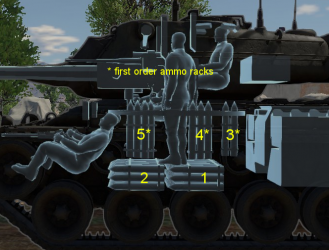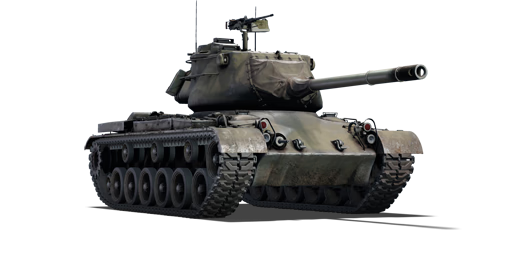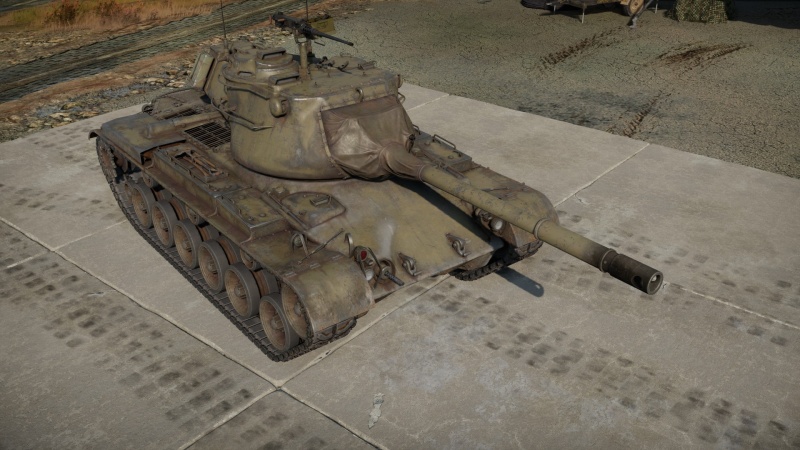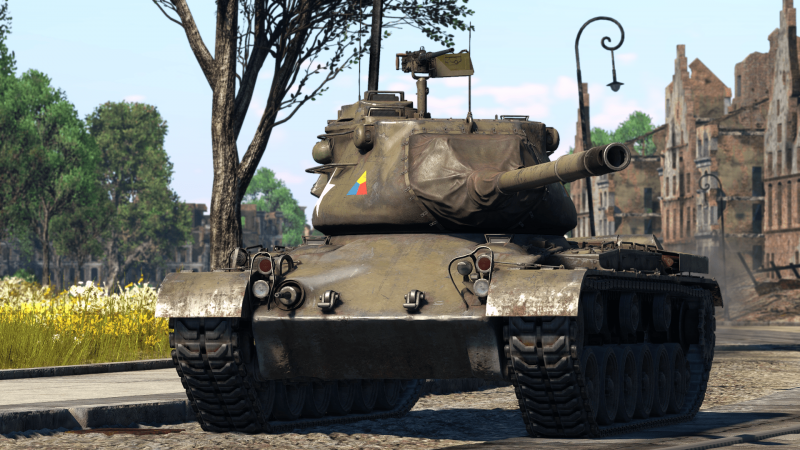Difference between revisions of "M47"
m (New specs-card image) |
(→Machine guns: Updated) |
||
| Line 46: | Line 46: | ||
<!-- ''Write about the mobility of the ground vehicle. Estimate the specific power and manoeuvrability, as well as the maximum speed forwards and backwards.'' --> | <!-- ''Write about the mobility of the ground vehicle. Estimate the specific power and manoeuvrability, as well as the maximum speed forwards and backwards.'' --> | ||
| − | {{tankMobility|abMinHp= | + | {{tankMobility|abMinHp= 1,255|rbMinHp= 716}} |
=== Modifications and economy === | === Modifications and economy === | ||
| Line 175: | Line 175: | ||
! Mount !! Capacity (Belt) !! Fire rate !! Vertical !! Horizontal | ! Mount !! Capacity (Belt) !! Fire rate !! Vertical !! Horizontal | ||
|- | |- | ||
| − | | Coaxial || | + | | Coaxial || 1,700 (200) || 577 || N/A || N/A |
|- | |- | ||
| − | | Pintle || | + | | Pintle || 550 (200) || 577 || -10°/+30° || ±180° |
|- | |- | ||
|} | |} | ||
| Line 266: | Line 266: | ||
* [https://tanks-encyclopedia.com/coldwar/us/m47_patton.php <nowiki>[Tanks Encyclopedia]</nowiki> 90mm Gun Tank M47 Patton II] | * [https://tanks-encyclopedia.com/coldwar/us/m47_patton.php <nowiki>[Tanks Encyclopedia]</nowiki> 90mm Gun Tank M47 Patton II] | ||
| + | {{TankManufacturer Ordnance Department}} | ||
{{USA medium tanks}} | {{USA medium tanks}} | ||
Revision as of 14:36, 4 July 2022
| This page is about the American medium tank M47. For other versions, see M47 (Family). |
Contents
Description
The 90 mm Gun Tank M47 Patton II is a rank V American medium tank with a battle rating of 7.3 (AB/RB/SB). It was introduced in Update 1.45 "Steel Generals" along with the rest of American Ground Forces. It uses a similar hull as its predecessor, the M46 Patton, but features a new turret and a better gun.
General info
Survivability and armour
Armour type:
- Cast homogeneous armour (Front hull, turret, cupola)
- Rolled homogeneous armour (Hull sides, rear and roof, turret roof, cupola roof)
| Armour | Front (Slope angle) | Sides | Rear | Roof |
|---|---|---|---|---|
| Hull | 101.6 mm (59°) Upper glacis 75 mm (24-76°) MG port bulge 170 mm MG port housing 40 mm MG port 90 mm (52°) Lower glacis - Top 76.2 mm (27-54°) Lower glacis - Bottom |
85 mm Top - Front 38-50.8 mm Top - Rear 25.4 mm (67°) Bottom |
60 mm Upper plate - Centre 22.2 mm (60°) Lower glacis - Centre 38-50.8 mm Sides |
22.2 mm (0-16°) 25.4 mm (spherical) Front hatches |
| Turret | 121 mm (spherical) Turret front - Centre and Bottom 101.6 mm Turret front - Top 62-74 mm Gun mantlet |
63.5 mm (22-27°) 16 mm (spherical) Optics port |
76.2-90 mm | 25.4 mm |
| Cupola | 76.2 mm (cylindrical) | 76.2 mm (conical) Outer ring 25.4 mm Centre | ||
Notes:
- Suspension wheels are 20 mm thick and tracks are 30 mm thick.
- Belly armour is 25.4 mm thick.
- Storage boxes and mudguards are 5 mm thick.
- Turret bustle rack is 15 mm thick.
At rank V, the M47 does not have suitable armour to survive direct hits from the numerous 88, 100, and 122 mm calibres fielded. Its best chance for survival is to flank enemies.
Mobility
| Game Mode | Max Speed (km/h) | Weight (tons) | Engine power (horsepower) | Power-to-weight ratio (hp/ton) | |||
|---|---|---|---|---|---|---|---|
| Forward | Reverse | Stock | Upgraded | Stock | Upgraded | ||
| Arcade | 54 | 22 | 46.2 | 1,255 | 1,545 | 27.16 | 33.44 |
| Realistic | 49 | 20 | 716 | 810 | 15.5 | 17.53 | |
Modifications and economy
Armaments
Main armament
| 90 mm M36 | Turret rotation speed (°/s) | Reloading rate (seconds) | |||||||||||
|---|---|---|---|---|---|---|---|---|---|---|---|---|---|
| Mode | Capacity | Vertical | Horizontal | Stabilizer | Stock | Upgraded | Full | Expert | Aced | Stock | Full | Expert | Aced |
| Arcade | 71 | -10°/+19° | ±180° | N/A | 34.3 | 47.4 | 57.6 | 63.6 | 67.8 | 9.75 | 8.63 | 7.95 | 7.50 |
| Realistic | 21.4 | 25.2 | 30.6 | 33.8 | 36.0 | ||||||||
Ammunition
| Penetration statistics | |||||||
|---|---|---|---|---|---|---|---|
| Ammunition | Type of warhead |
Penetration @ 0° Angle of Attack (mm) | |||||
| 10 m | 100 m | 500 m | 1,000 m | 1,500 m | 2,000 m | ||
| M318A1 shot | APBC | 193 | 190 | 177 | 162 | 148 | 136 |
| M82 shot | APCBC | 185 | 182 | 170 | 155 | 142 | 130 |
| M304 shot | APCR | 287 | 281 | 259 | 234 | 211 | 191 |
| M332 shot | APCR | 321 | 316 | 292 | 265 | 240 | 218 |
| M431 shell | HEATFS | 320 | 320 | 320 | 320 | 320 | 320 |
| M71A1 shell | HE | 13 | 13 | 13 | 13 | 13 | 13 |
| Shell details | |||||||||
|---|---|---|---|---|---|---|---|---|---|
| Ammunition | Type of warhead |
Velocity (m/s) |
Projectile Mass (kg) |
Fuse delay (m) |
Fuse sensitivity (mm) |
Explosive Mass (TNT equivalent) (g) |
Ricochet | ||
| 0% | 50% | 100% | |||||||
| M318A1 shot | APBC | 912 | 10.98 | N/A | N/A | N/A | 47° | 60° | 65° |
| M82 shot | APCBC | 853 | 10.94 | 1.2 | 14 | 137.2 | 48° | 63° | 71° |
| M304 shot | APCR | 1,021 | 7.62 | N/A | N/A | N/A | 66° | 70° | 72° |
| M332 shot | APCR | 1,249 | 5.7 | N/A | N/A | N/A | 66° | 70° | 72° |
| M431 shell | HEATFS | 1,216 | 5.8 | 0.05 | 0.1 | 712.64 | 65° | 72° | 77° |
| M71A1 shell | HE | 732 | 10.55 | 0 | 0.1 | 925 | 79° | 80° | 81° |
| Smoke shell characteristics | ||||||
|---|---|---|---|---|---|---|
| Ammunition | Velocity (m/s) |
Projectile Mass (kg) |
Screen radius (m) |
Screen deploy time (s) |
Screen hold time (s) |
Explosive Mass (TNT equivalent) (g) |
| M313 | 821 | 10.7 | 13 | 5 | 20 | 50 |
Ammo racks

| Full ammo |
1st rack empty |
2nd rack empty |
3rd rack empty |
4th rack empty |
5th rack empty |
Visual discrepancy |
|---|---|---|---|---|---|---|
| 71 | 42 (+29) | 12 (+59) | 10 (+61) | 7 (+64) | 1 (+70) | No |
Note:
- As they are modeled by sets of 2, shells disappear from the rack only after you fire both shells in the set.
- Shells are modeled by sets of 2 and disappear from the rack after both shells in the set having been shot or loaded.
- Racks 3 to 5 are first stage ammo racks. They total 11 shells and get filled first when loading up the tank.
- These racks are also emptied early: the rack depletion order at full capacity is: 3 - 4 - 5 - 1 - 2.
- Simply not firing when the gun is loaded will move ammo from racks 1-6 into racks 8 then 7. Firing will interrupt the restocking of the ready racks.
Machine guns
| 12.7 mm M2HB | ||||
|---|---|---|---|---|
| Mount | Capacity (Belt) | Fire rate | Vertical | Horizontal |
| Coaxial | 1,700 (200) | 577 | N/A | N/A |
| Pintle | 550 (200) | 577 | -10°/+30° | ±180° |
The M47 comes with 2 M2HB 0.50 cal machine guns (1 coaxial and 1 roof-mounted), providing a concentrated stream of heavy machine-gun fire to target low-flying aircraft or lightly armoured vehicles.
Usage in battles
The M47 is very much a glass cannon. With a powerful gun, but weak armour, this vehicle should be played carefully, and out of sight of the enemy. As such, it is often beneficial to use an ambush or flanking-based play-style. Attacking enemies without being seen will maximize this tank's capabilities.
The stock APBC shell is quite weak compared to the shells used by the M47's enemies. While working towards the much better HEAT-FS shell, it is advisable to shoot for enemies' tracks and gun barrels if the main hull is too-well protected for the APBC shell to penetrate. Doing so will help to incapacitate your enemies and support your better-armed teammates. Additionally, the M47 should never have any trouble dealing with soft targets. With two 12.7 mm machine guns in addition to the main cannon, light tanks and armoured cars can be dispatched with ease. (On a side note, these machine guns can be used to spot enemy targets, alerting your team to their presence.)
Once the HEAT-FS shell is unlocked, the M47 may be played more like a classic medium tank. There will be few vehicles that the upgraded shell cannot penetrate. It is recommended to play near friendly vehicles, in case support is needed--even with an upgraded shell, the M47 is not a lone wolf, and will suffer without the backup of its allies.
The M47 has above-average mobility, and achieving flanking positions should not pose too much difficulty. However, the tank does have a high-profile, making it easily spotted. Combined with the vehicle's poor armour, this makes it especially important to stay out of the enemy's sight.
Pros and cons
Pros:
- Good mobility, same handling as the M46
- Great turret traverse speed once upgraded
- Decent front armour, more sloped than the M46
- 320 mm HEATFS ammunition once unlocked
- Gun depression of -10° is usually sufficient
Cons:
- Overall bad armour for Rank V matches, especially in the turret
- The gun is not very good with stock ammo, recommended to unlock HEATFS as soon as possible
- Mobility is limited or even rather poor until modifications are purchased.
History
Development
The M47 Patton came about only a few years after its predecessor, the M46 Patton. The basis of this design was the M26 Pershing, which was deemed insufficiently mobile for its role as a medium tank. The M46 was mainly the M26 Pershing with a new engine, transmission, and a redesigned 90 mm gun. While a good solution for the lacking M26 Pershing design, it was only considered a stopgap solution while the experimental T42 medium tank was being developed. However, the Korean War put a stop in that development due to an urgent need of tanks, so the T42 project, which would produce a completely new tank design, was put on hold.
An interim decision was made to mount the turret from the T42 onto the hull of the M46 Patton, this modified tank was designated the M47 Patton and entered production in 1951. A common nickname for the tank was the Patton II, due to the same name as the M46 Patton, this was changed to Patton 47 a few weeks later. The M47 Patton featured most of the armament seen from the M26 Pershing and M46 Patton, with a 90 mm gun and a coaxial and hull-mounted .30 cal machine gun, and a .50 cal machine gun on top of the turret. The M47 Patton has the distinction of being the last American tank with the hull-mounted machine gun on the bow. The new turret required the hull to be redesigned with a larger turret ring and had a "needle-nose" design with the turret mantlet heavily sloped towards the cannon, the design's heavy sloping nature also helped improve protection. The turret also had a large protrusion at the back to act as storage. An M12 stereoscopic range finder was also mounted on a turret, which was difficult to use, but would appear in every American tank design from here on until the M1 Abrams design.
Though technically a medium tank by the army standards, a new standardization in US Army tank designation on November 9, 1950, had the entire system changed from the weight of the tank to the calibre of the vehicle's gun. Therefore in the 1950s, the "Medium Tank M47 Patton" name was changed to 90 mm Gun Tank M47 Patton. This designation would go on for future American tank designs. The M47 Patton began production in June 1951 before its standardization at the Detroit Tank Arsenal. Delays in the production schedule caused a long period of testing to occur until it was standardized in May 1952. Production ran until November 1953 with a total production number of more than 9,000 M47 Pattons between Detroit and Alco.
Usage
The M47 Patton came out only a year before the improved M48 Patton. Because of this, the M47 was declared a "limited standard" in American service, and those still in American hands were replaced by the M48 Patton tanks. It was declared obsolete by 1957 and were only retained by infantry divisions until replaced by anti-tank missiles in the 1960s. The M47 Patton was given out in large numbers to a number of countries in NATO and SEATO, such as Pakistan, Jordan, Turkey, Iran, Croatia, France, West Germany, and Spain. The M47 Patton would see service in combat in both Indo-Pakistani Wars, the Six Day War, the Iran-Iraq war, the Invasion of Cyprus, and the Croatian War of Independence. Today, they are still being used in Spain as armour recovery vehicles in artillery and infantry units.
The M47 Pattons were promising new designs developed from the M46 Pattons to improve its combat capabilities with a newer turret. However, it did not serve much in America due to the M48 Patton development, which was a completely new design and had nearly no identical parts with its predecessor. It served very well in other countries as their primary armour forces, but those left in the states were used as targets in firing ranges, mainly for training or as tests for future anti-tank developments. In the 1970s, one was tested against the M60 Main Battle Tank, the successor to the M48 Patton, and its 105 mm L7 gun. The HEAT round fired from the gun penetrated the frontal armour of the M47 Patton with relative ease, armour which was considered superb at its time of introduction. The test went on with many M47 tanks and would prove that conventional steel armour in tank warfare was becoming obsolete in the face of new tank ammo.
In-game description
The M47 Patton II medium tank, released in the US beginning in June 1951 by the Detroit Tank Arsenal and the American Locomotive Co., was a modernized version of the M46 Patton.
The M47's frontal hull sheets were more sloped, while infrared viewfinders and a heater were added for the crew. The construction for the cast turret was also updated: it took a step forward from the M46, though the builders reduced its interior space in order to add a cupola and reloader's hatch in its overhangs. As a result, indentations were made that proved excellent at catching shells. That error was rectified for the M48 by making the turret fully domed, similar to the Soviet T-54. The tank's armament was reinforced by modernizing the 90 mm cannon, resulting in an initial velocity of over 900 m/s. The M47 hull also differed from the M46: its front section was more streamlined, while the fan hood between the driver and gunner disappeared. Engine power was added, though the tank's top speed remained the same (although the average terrain it encountered was somewhat higher).
As a result, the M47 did not become standard for American tank construction, and it was quickly replaced in its limited role for the US Army (two divisions in West Germany) by the M48. However, it was actively distributed among NATO countries and other US-dependent allies, resulting in total production of 8,676 units.
The M47 Patton II was part of the West German, Austrian, French, Italian, Belgian, Spanish, Jordanian, Japanese, and Turkish armies.
Media
- Skins
- Videos
See also
- Vehicles equipped with the same chassis
- Other vehicles of similar configuration and role
External links
| USA medium tanks | |
|---|---|
| M2 | M2 |
| M3 | M3 Lee · ▃Grant I |
| M4 | M4 · Calliope · M4A1 · M4A1 (76) W · M4A2 · M4A2 (76) W · M4A3 (105) · M4A3 (76) W · M4/T26 |
| M26 Pershing | T20 · T25 · M26 · M26 T99 · M26E1 |
| M46/47/48 Patton | M46 · M46 "Tiger" · M47 · M48A1 · T54E1 · T54E2 |
| M60 | M60 · M60A1 (AOS) · M60A1 RISE (P) · M60A2 · M60A3 TTS · M728 CEV · 120S |
| MBT-70 | MBT-70 · XM803 |
| M1 Abrams | XM1 (Chrysler) · XM1 (GM) |
| M1 Abrams · M1 KVT · IPM1 | |
| M1A1 · M1A1 HC · M1A1 Click-Bait | |
| M1A2 Abrams · M1A2 SEP · M1A2 SEP V2 | |
| Other | T95E1 |
| Australia | M1A1 AIM |
| Canada | M4A5 |
| Israel | ▃Magach 3 (ERA) · ▃Merkava Mk.1 · ▃Merkava Mk.2B · ▃Merkava Mk.3D |
| Turkey | M60 AMBT |






